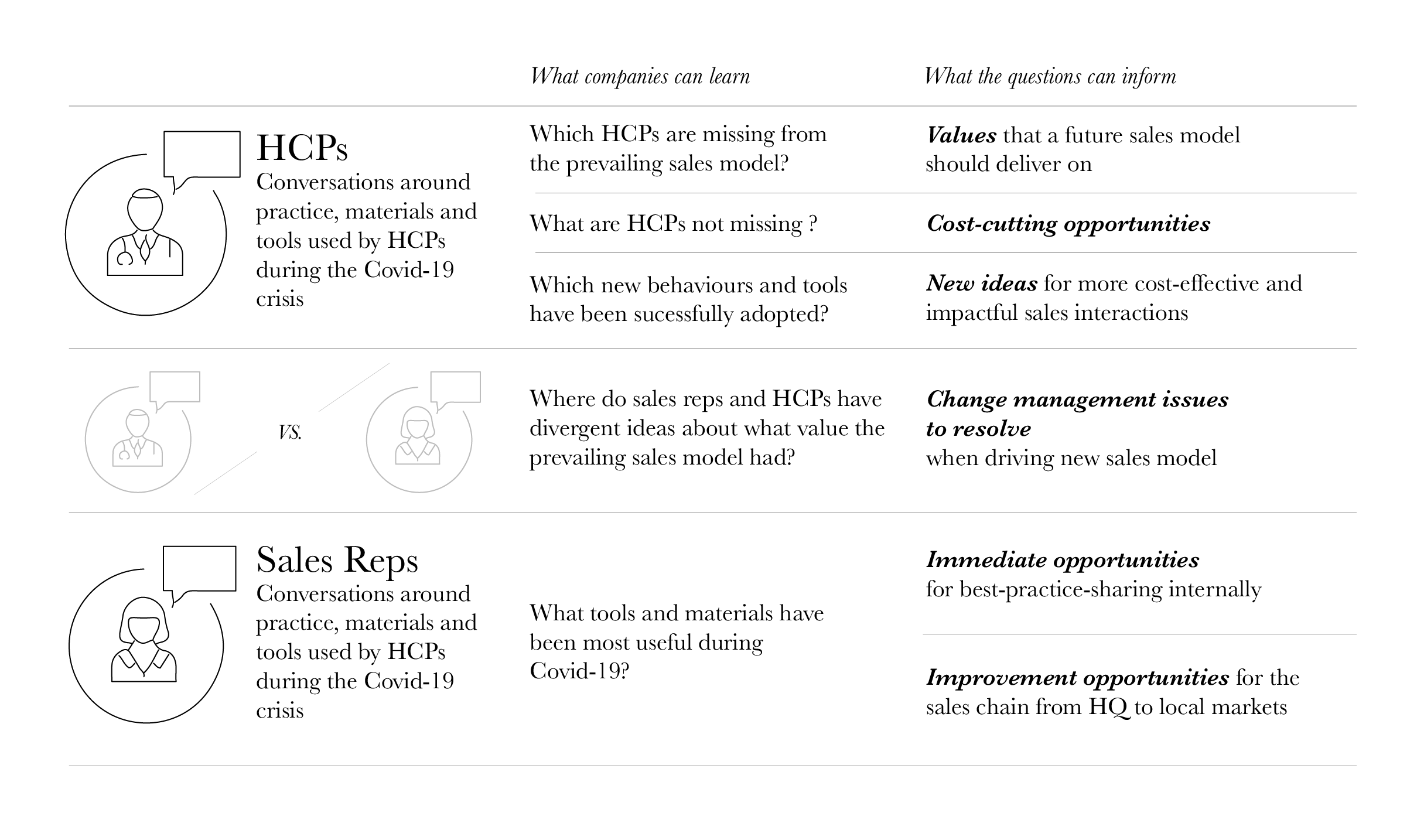Covid-19: Now is the Time to Reinvent the Sales Model in Healthcare
By Martin Gronemann and Anne Mette Worsøe Lottrup
The COVID-19 pandemic has the potential to rip the band-aid off dysfunctional healthcare systems. The massive force of this external shock has already accelerated changes that would have taken years – if not decades – to come about. An obvious example has been the widespread adoption of telemedicine, which is now used by more than 90 percent of primary clinics in England. We believe that this period of disruption presents an opportunity for life sciences companies to interrogate one of the most profound questions in the industry: What value does the prevailing and expensive sales model actually deliver to HCPs –and how could a system of wasted resources be reformed?
The Rep-centric sales model has been scrutinized for years
The sales force is the most expensive commercial investment for most life sciences companies, often costing tens –if not hundreds – of millions of dollars yearly. The traditional rep-centric sales model has been heavily reliant on repeat face-to-face interactions with healthcare professionals, which has made it costly, unpredictable, and often ineffective. Sales teams continue to spend great amounts of time in their cars, in waiting rooms or cafeterias hoping to get a few minutes of face time with a target HCP – with no guaranteed results. Companies have had little success in optimizing the interactions between reps and HCPs to increase return on investment. While there is widespread recognition that the sales model can be improved, there is no consensus in the industry around what works and what doesn’t. Attempts to simply ask preoccupied HCPs how they would like to be serviced does not result in meaningful options and solutions.
Amidst Covid-19, there is a unique opportunity to learn what value the prevailing sales model brings to HCPs –and where it is simply a waste of resources
As social scientists know, one of the biggest challenges in making sense of human behaviour is that often people are not aware of why they do what they do. Our everyday lives are filled with autopilot behaviours like opening a door, driving a car, brushing our teeth. And if you are an HCP, meeting with sales reps is part of what you do on a normal day. While some HCPs may cast a critical eye toward this practice, they are so busy and preoccupied that they are more likely to continue this ingrained pattern than challenge it.
What would happen if we removed sales reps from HCP offices for awhile to see how that changes the providers’ decision-making and approach to treatments? In the social sciences we call that a breaching experiment. It is an effective ethnographic technique for gaining deeper insight into autopilot behaviours (without conducting lengthy observations)1, where people are asked to remove a product or service from their life for a time, to have them reflect on their value and observe the workarounds they develop to fill its absence. We asked teenagers to refrain from using social media for a week so they could clearly feel and articulate the value social media brought to their everyday. We asked parents to turn off their alarm system for a week so they could experience the actual value their alarm system brought to their household. In many cases, our breaching exercises yield stark insights about the needs that certain products and services fulfill.
COVID-19, has created a live breaching experiment that life sciences providers could never have conducted themselves. Physical interactions between reps and HCPs have been removed. This is a unique opportunity to evaluate the prevailing sales model. Instead of asking HCPs what they would miss if sales reps weren’t around, it is now possible to talk to them about what they have missed.
Life Sciences companies that seize this momentum can capture market share short-term, but also get a head start in defining tomorrow’s sales model
The uncertainty wrought by COVID-19 applies to so many aspects of the healthcare system, so it is hard to predict how the sales model will evolve. However, life sciences companies have an opening to show leadership around modeling a new system and closely studying this un-precedented social experiment to get ahead of the competition in the near and long term.
Short term: Identifying new tools and practices that have helped sales reps and HCPs adapt to this new environment; driving adoption of these tools widely across the organization to increase sales in the short-term.
Long term: Capturing what HCPs and sales reps miss most (or do not miss) about face-to-face interactions; Using that research to formulate new hypotheses and ideas on sales situations that could be more cost-effective and impactful than in the prevailing model.
What Life Sciences companies can learn during Covid-19 and how these insights can improve the sales model.
The window is now. As COVID-19 cases decline, the healthcare ecosystem will start to normalize in some countries (e.g. Nordics and Germany) and practitioners may have more time for reflective conversations. Some non-emergency specialists even have more bandwidth in times of social distancing, as people postpone consultations – leaving offices mostly empty. We can learn from HCPs and sales reps in these countries and look at common denominators across markets.
The COVID-19 pandemic comes with a great deal of uncertainty for the industry. But it is also an unprecedented opportunity for life sciences companies to make limited investments to take a critical look at reforming existing practices and innovate. This is a –hopefully once-in-a-lifetime– chance for sales and marketing leaders to learn from HCPs’ experiences when operating outside the prevailing sales model, and use these insights to define future interactions that are more cost-effective and have greater impact.
We would love to hear your perspective on this approach and talk further about the work being conducted by ReD’s health care practice.
[Banner image by Mufid Majnun, via Unsplash]

